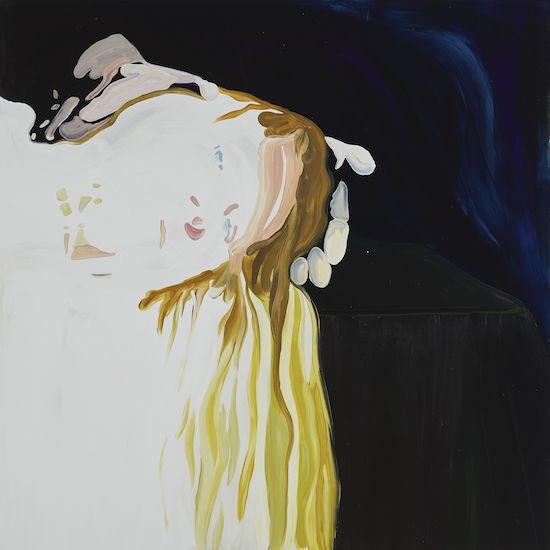Clare Woods, Ownlife, 2019, oil on aluminium. 150 x 150 3cm
We begin with a scream. A painting called Memory Hole (all works, 2019) confronts us with a black void: a dark maw rimmed with vermillion contains a large amorphous pulpy bacon-pink blob; isolated blocks of straw yellow, looking like chunks of popcorn, float to the north and south of the canvas. What might (fleetingly) be taken for abstraction is quickly interpreted as a gob with a tongue, lips, and the dense dentine of new teeth isolated amidst spongy, sore-looking, gums.
A photograph of her young daughter’s mouth inspired this painting. But Woods is no benign tooth fairy: her destabilizing practice, as evidenced in many of the other works here, wobbles precariously, albeit intentionally, on a high wire that spans the twin poles of ugliness and beauty: hence the reference to doublethink from 1984 in the title of her new show. Similarly, the memory hole mentioned here is the mechanism in the novel by which the Ministry of Truth rids and rewrites unwelcome reminders of the past. Woods is unapologetically explicit in pointing out we live in Orwellian times.
Big Brother is watching and doesn’t like us spending any of our time in solipsistic reverie; we must obey the diktats. Woods references those precious moments of solitude with a rare self-portrait called Ownlife. This captures the artist’s face as she lies to the left of the canvas, her pallor in stark contrast to the gloom of the deep purple and navy surrounds; her corn-coloured hair drapes down in streaks, thin streams that pour to the bottom of the canvas; her eyes and nose and mouth are telegraphed markings of steel blue and pale pink. We see a woman alone with her thoughts, inaccessible, private; perhaps she’s enjoying a fleeting moment in control. The title again is from 1984, a Newspeak term that considers individualistic behaviour anti-social.
So where might Woods suggest we seek succour in this dishonest era? In nature perhaps? Woods is great at flowers and vegetation and dares to resuscitate the lifeless as with It’s the end of the World as we know it, which revivifies a group of dead peonies sat in a vase. Stalks droop, petals flop, but the shamrock greens and Bazooka Joe pinks appear vital, further evidence of the artist’s interest in the paradoxical: how can something quite inert look so alive?
Woods often uses found photography as source material and is adept at gingering up tired clichés, as with How Little I Know, another still life. Here a bunch of flowers seems to explode in our face; their bruised violets spreading like a priest’s Lenten vestments over adipose whites; their fleshy, rose-coloured smears might be compared to a twist of intestinal coils, or a string of sausages ripe for frying.

Clare Woods, Doublethink, Simon Lee Gallery, London, Installation View
Down in the basement of the gallery is Still Even measuring a monumental 260x462x3cm: this is a three-panel oil on aluminium that depicts another found image, this time a double-page spread taken from an opened book complete with spine and its folds. We see exceptionally pleasing variations of green: there are lime and sage colours, chartreuse shadings, mint and pistachio splashes. Some might be nauseated by the bile fluid tints of the jug but Woods has a smart purchase on the fulcrum between delight and disgust.
Trying to fix an image of the mutable is the quixotic task Woods sets herself with The Upsidedown, where an Alpine tree is caught in the flux of the weather. What might be a snowstorm attacks in a whiteout of angry broad brushstrokes, squiggles of purple tinted snowmelt dribble off the dark foliage. Woods revels here in the near sculptural solidity her oils have on aluminium.
Such conjunctions of abstraction and figuration are, of course, a not uncommon sight in modern painting. Comparisons might made to other British painters like Richard Patterson, or Glenn Brown, particularly in a work like The Cook where Woods gives us an unstable image of an injured and bandaged hand held vertically, seemingly elevated to reduce inflammation. The middle and index fingers are raised in a Christ-like fashion like a benediction, as if in approval of the artist’s intentions.
As with her aforementioned peers Woods has a bravura technique perhaps best noted here in This is Now where she captures the reflection of a Murano chandelier in the giant mirror of a Venetian palazzo. There’s a dreamy, near Dali-esque, deliquescence with the frame de-solidifying like a runny Époisses. The mood turns darker again with The Allnighter, a painting of another photograph, this time by Peter Hujar, of a man lying in a hospital bed with his eyes closed. This could be a death mask. Icy blues outline his cheeks: his face as it rests on the pillow threatens to sink into the depths of an ocean of nothingness, that other void: the empty, stark reality of death.
But apart from the fact of death where else is truth situated? Orwell was clearly suspicious of the assertion (attributed to F. Scott Fitzgerald) that to hold two opposing ideas in the mind and still function was a sign of a first-rate intelligence. He knew that nearly everybody is capable of doing that. In 1984 Orwell explicitly warns us that the Powers-That-Be will exploit such a delusion and will, as he defines doublethink, “tell deliberate lies while genuinely believing in them, to forget any fact that has become inconvenient.”
Our current political situation in the West empowers those who delight in arguing the inarguable; sophistry is the only game in town right now, and the winners are those who lie the most convincingly. Woods reflects on this and majors in the complexities of painterly representation; her works insist that we must question the ‘truths’ we are presented with.
Clare Woods: Doublethink is at Simon Lee, London, until 6 October 2019


